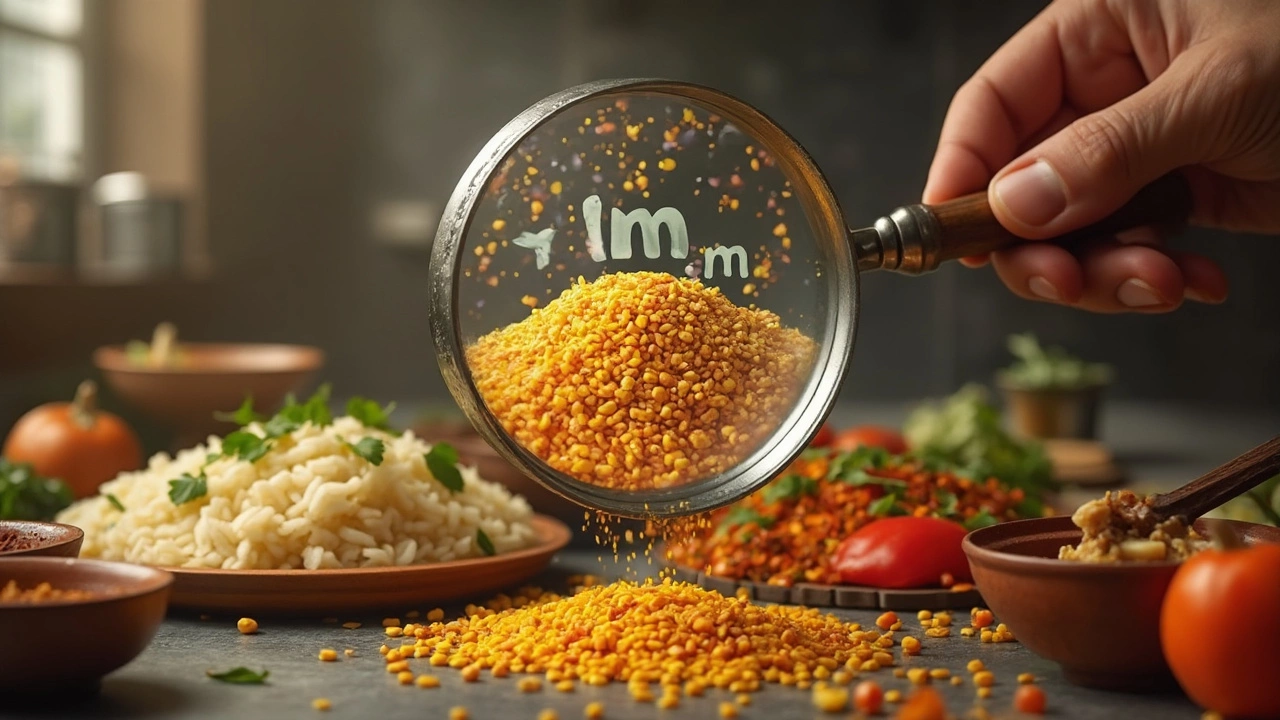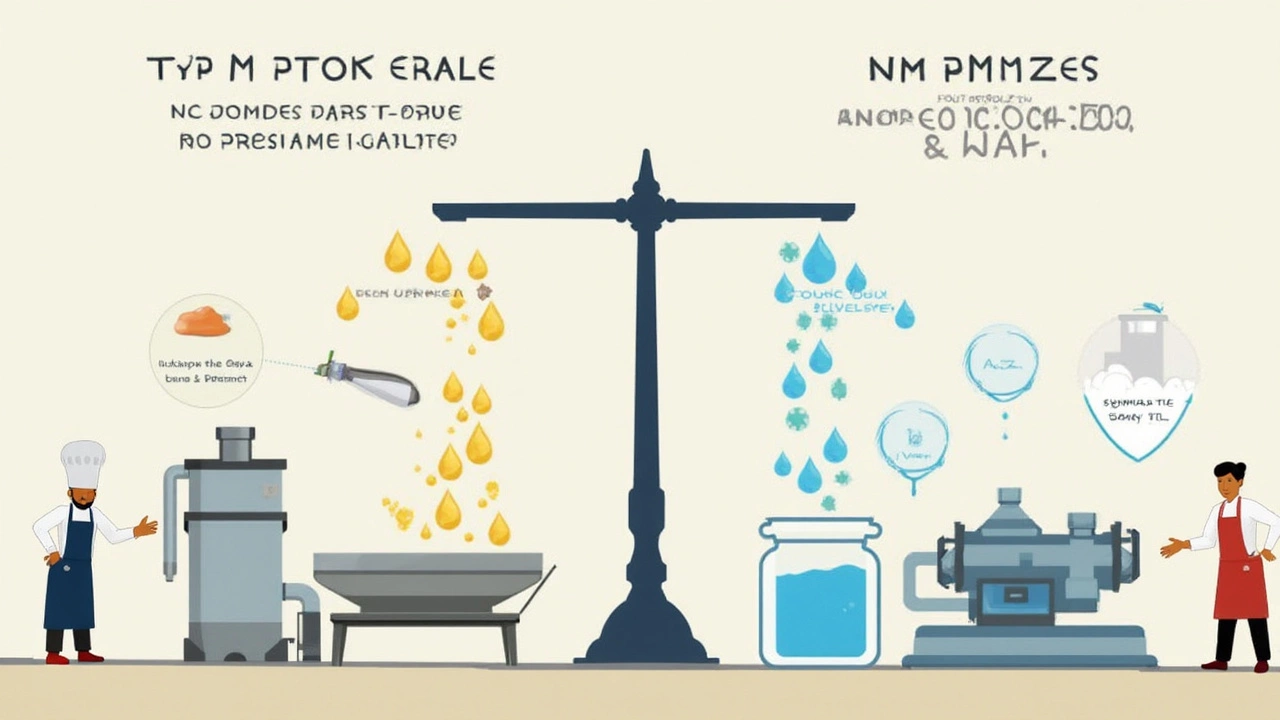Ever stared at labels or manuals in a food factory and wondered, “Is a μm (micrometer) bigger than an NM (nanometer)?” You’re not alone. These little numbers can mess with your head, especially when you’re trying to choose the right filter or tweak a processing line. But here’s the thing: μm is actually a thousand times bigger than NM. Yep, it’s not even close.
This size difference isn’t just something for science nerds—it’s a big deal when you’re talking about things like filter mesh, grinding particles, or making sure your food is as safe and smooth as possible. Getting it wrong could mean letting bacteria through a filter or missing out on top texture in your end product.
- Micrometers vs Nanometers: What Do They Mean?
- How These Units Matter in Food Processing
- Where Do You Find μm and NM in Real Food Equipment?
- Why Precision Down to μm or NM Changes Food Quality
- Quick Tips for Reading and Using These Units
Micrometers vs Nanometers: What Do They Mean?
When folks see μm and NM on a piece of equipment or a spec sheet, they often freeze up. But it’s actually easy to tell the difference. A μm (micrometer) is one millionth of a meter (that’s 0.000001 meters), while an NM (nanometer) is one billionth of a meter (0.000000001 meters). So, a micrometer is 1,000 times bigger than a nanometer. If you line up 1,000 nanometers, you’d get the length of just one micrometer.
To make it clearer, here’s a simple size chart comparing how these units stack up:
| Unit | Symbol | Size in Meters | Relative Size |
|---|---|---|---|
| Micrometer | μm | 0.000001 | 1 micrometer |
| Nanometer | NM | 0.000000001 | 0.001 micrometers |
Why are these tiny numbers even a thing in food processing? Because they help us measure things way smaller than what you can see with your eyes. Think about bacteria—they’re usually 1-10 μm in length. Viruses are even smaller, like 20-200 NM. So if you want a filter or processor that catches or shreds stuff at that size, you need to use these units.
Here's a quick way to remember it: μm is used more for stuff you still might see with a basic microscope, like flour particles or bacteria. NM jumps in when things get seriously tiny, like proteins and viruses—stuff only big lab gear can catch.
How These Units Matter in Food Processing
In food processing, μm and NM aren’t just geeky units—they make or break your product safety and quality. When you see a filter marked as 0.2 μm, it means it can trap most bacteria but lets water and tiny molecules through. If you’re working with nanometers (NM), that’s a whole different league—think viruses or things smaller than proteins.
Check out this real difference between micrometers (μm) and nanometers (NM) in common food tech:
| Equipment | Typical Size Used | What It Catches or Affects |
|---|---|---|
| Standard microfilters | 0.5 – 5 μm | Bacteria, large particles |
| Ultrafiltration systems | 10 – 100 NM | Viruses, fine proteins |
| Homogenization gaps | 1 – 10 μm | Fat globules, texture control |
| Membrane nanofilters | 1 – 20 NM | Minerals, salts, smallest contaminants |
Let’s talk cheese—the classic example. If you use a microfilter set to around 1 μm, you’ll keep the flavor in but cut out most bacteria. Drop down to nanometers for some dairy applications and now you’re taking out viruses or filtering protein sizes to separate whey from casein.
Another spot where these units show up is in food powders and emulsions. Particle size can affect how easily something mixes, how smooth it feels, or even how long it lasts on the shelf. A cocoa powder milled to 20 μm will behave completely differently compared to one ground down to hundreds of NM.
You really can’t afford to wing it with these units. Too big (wrong μm), and stuff slips through you never wanted in your product. Too tiny (NM filters everywhere) and you risk clogging up your systems or making the process more expensive than it needs to be. Always check the specs for food processing units; these numbers are your friends if you want consistent, quality food at scale.

Where Do You Find μm and NM in Real Food Equipment?
Walk into any modern food factory, and you’ll spot μm and NM all over the place. These units pop up on filters, grinders, homogenizers, and quality control sheets. The reason? Food processing needs crazy precision—sometimes you’re catching stuff you can't even see with your eyes.
μm (micrometer) levels show up most in filtration and grinding gear. Think about milk processing: if you want to remove bacteria but keep the taste, you’ll use microfilters around 0.5 μm to 1.2 μm. Coffee grinders often talk about grind size in micrometers. If you use too big particles, you get weak coffee. Too fine, and your filter gets clogged.
Now let’s get smaller: NM (nanometer) levels show up in more high-tech stuff like nanofiltration units or certain sensors that check for contaminants. For example, nanofiltration membranes can remove dissolved salts or proteins down to 1 NM to 10 NM. That’s way, way smaller than a bacterium.
| Equipment | Typical Size (μm) | Typical Size (NM) |
|---|---|---|
| Milk Microfilter | 0.1 - 1.2 μm | 100 - 1200 NM |
| Coffee Grinder | 200 - 1000 μm | 200,000 - 1,000,000 NM |
| Nanofiltration Membrane | 0.001 - 0.01 μm | 1 - 10 NM |
| Particle Sensors | 0.1 - 5 μm | 100 - 5000 NM |
Here’s what Dr. Harish Patel, a food equipment expert at TechFood Labs, says:
“When you see numbers like 0.2 μm or 5 NM on a machine spec sheet, don’t ignore them. They tell you exactly what your equipment will capture or process. This can mean the difference between a safe, shelf-stable product and a recall.”
Always double-check those numbers, especially when you’re buying new parts or setting up a new line. Food safety and quality depend on getting them right.
Why Precision Down to μm or NM Changes Food Quality
When we talk about μm and NM in food processing, we're really talking about control. Even a tiny mistake in these measurements can ruin texture, mess up flavors, or, worse, let harmful bits sneak through. Think about filtering milk: filters with 1–2 μm holes are great at catching bacteria, but anything bigger and your safety goes out the window. On the flip side, jumping down to nanometer-sized filters? Now you're keeping out viruses. That level of detail can make or break quality and safety.
Here’s a quick look at just how much of a difference this stuff makes:
| Process | Common Measurement | Result |
|---|---|---|
| Milk Filtration | 1–2 μm | Catches most bacteria |
| Wine Clarification | 0.45 μm | Removes yeast & haze |
| Water Purification | 50–100 NM | Cuts out viruses |
Ever wondered why some bread is fluffier or why certain yogurts feel smoother? It's usually because the company nailed the exact particle size, keeping everything just right—either by milling, filtering, or emulsifying at the μm or NM level. Here’s what that means in real life:
- Ultrafine sugar (down to a few micrometers) dissolves faster, so your ice cream has zero gritty bits.
- Emulsifiers, broken down to a few NM, help mayo stay creamy and never split in the fridge.
- Microfilters can sort out even the tiniest unwanted particles, so juices look bright, not cloudy.
"Small changes at the micro or nano scale change everything about food, from taste to texture to shelf life." — Dr. Kevin Smith, Food Safety Engineer (2023, Institute of Food Technologists Annual Report)
The right tool with the right unit—μm or NM—doesn’t just make food better, it keeps it safer. If you want smooth sauces, clear drinks, or bread that stays soft, it's all about these tiny details.

Quick Tips for Reading and Using These Units
If you get lost between μm and NM, you’re not alone. When reading equipment specs or ingredient labels, remember: 1 μm (micrometer) is 1,000 times bigger than 1 NM (nanometer). That’s a gap you don’t want to mess up.
Here’s a straightforward tip: If you see numbers in single or low double digits with NM units, you’re talking about pretty tight filtration—often virus or nano-emulsion level. If the numbers are in the tens, hundreds, or thousands with μm, that’s more like bacteria or yeast filtration, or ingredient particle sizing in mixing and milling.
- Always check for the symbol: μm means micrometers, NM stands for nanometers. Don't mistake NM for "new meters"—that’s not a thing in food processing.
- If you want a finer filter, go with a lower unit and number, like 100 NM instead of 1 μm.
- When shopping or picking specs, check if your process needs to block bacteria (at least 0.2 μm) or something smaller like viruses (closer to 100 NM).
- If you mix “μm” and “NM” in calculations, always convert: 1 μm = 1,000 NM. It can save your batch from a bad mistake.
Here’s a simple table to make converting and visualizing these units easier:
| Unit | Abbreviation | Size in Meters | Common Use in Food |
|---|---|---|---|
| Micrometer (μm) | μm | 0.000001 m | Bacteria filtration, powder sizing |
| Nanometer | NM (nm) | 0.000000001 m | Virus filtration, nano-emulsions |
If you’re just skimming manuals or spec sheets, circle back and double-check the units. Mistaking one for the other can lead to either too much clogging or not enough filtering. Tiny numbers, huge impact. Don’t let it trip you up next time you’re working with food processing units.

